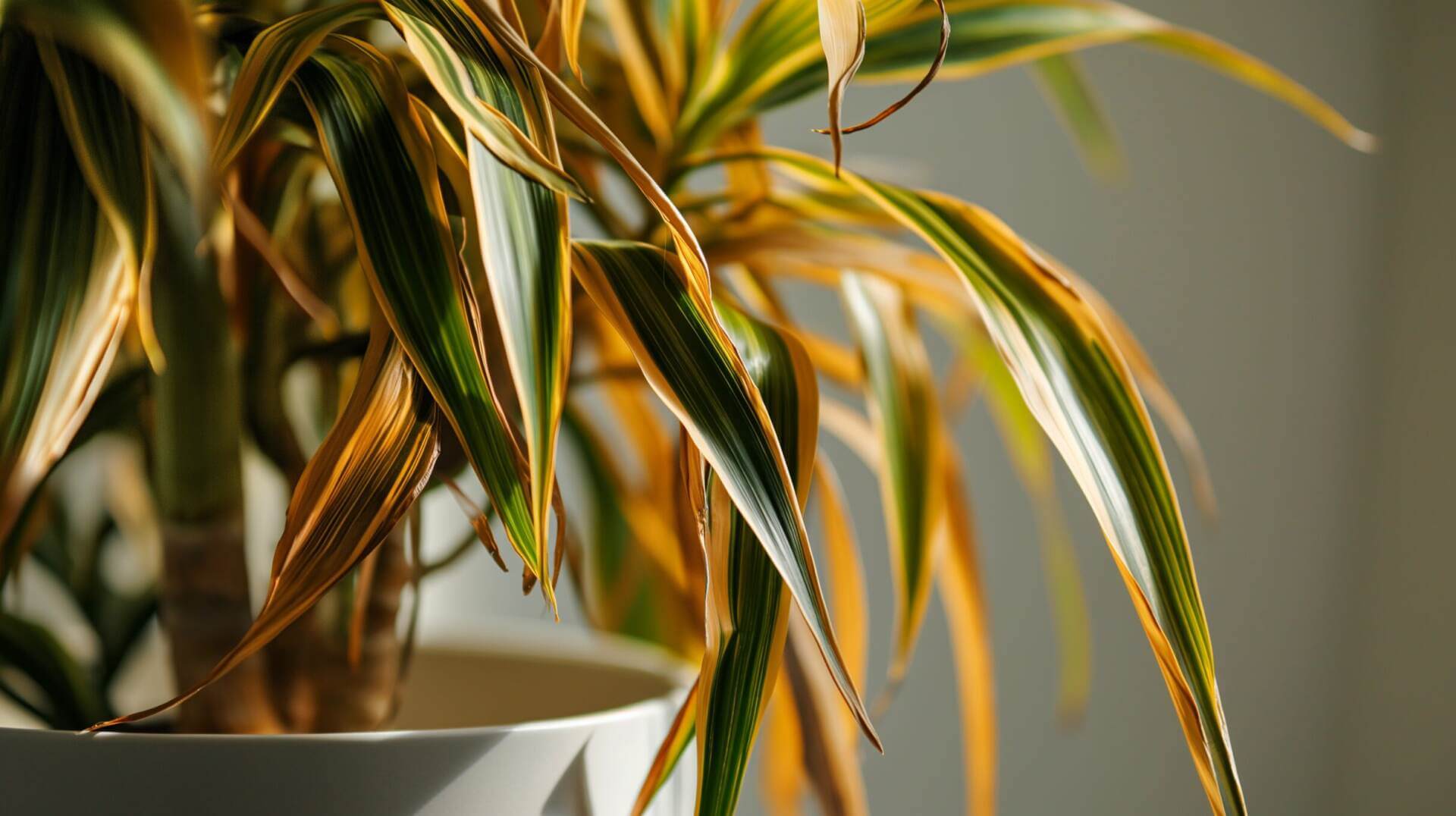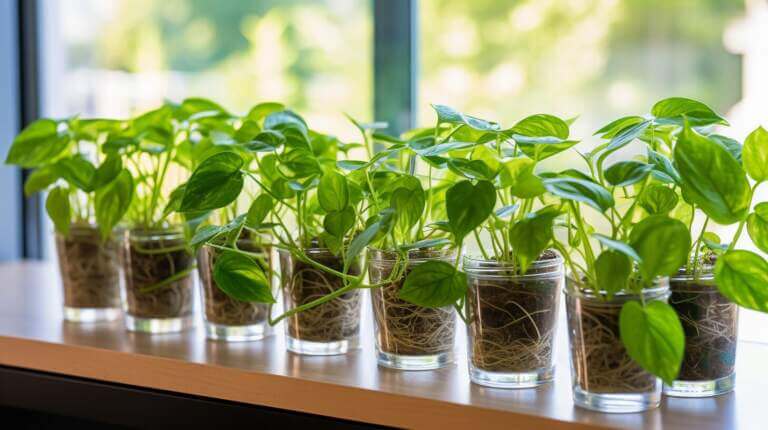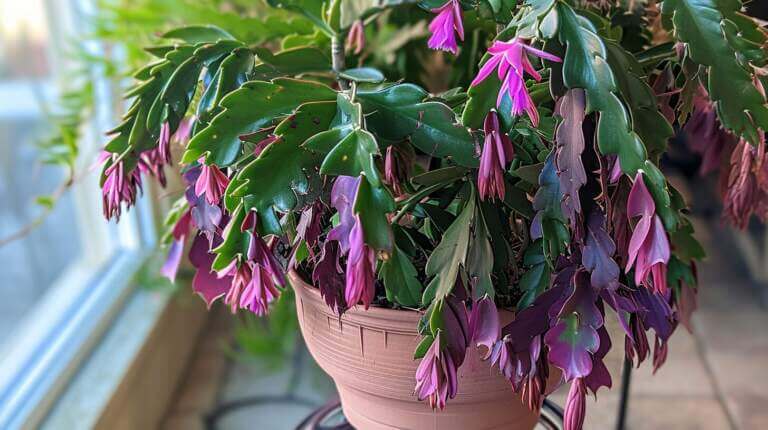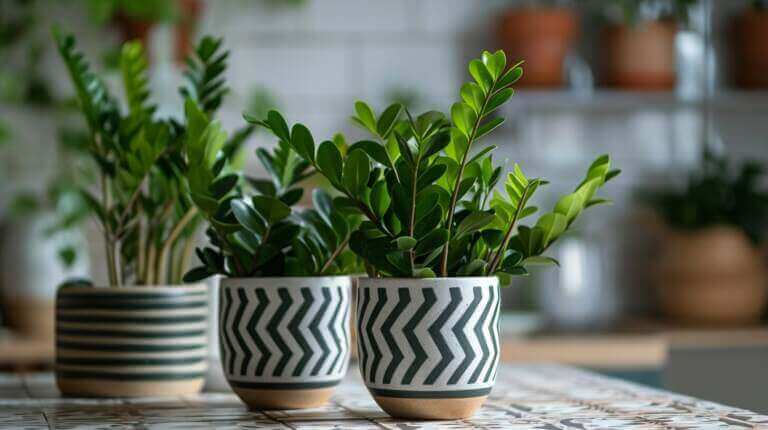Common Dracaena Plant Diseases and Pests: Easy Problems and Solutions Guide
Are you struggling with common Dracaena marginata(Madagascar Dragon Tree) or Dracaena Fragrans(Corn Plant) houseplant problems? Don’t worry, I’ve got you covered with easy solutions to keep your green friend healthy and happy.
Key Takeaways:
- Dracaena plants can experience common diseases such as browning and dying leaves, yellowing leaves, overwatering, and pest infestations.
- To prevent and solve these problems, provide your dracaena with the right lighting conditions, well-draining soil, and proper watering.
- Fertilizing the plant once or twice a year, regular pruning, and repotting when necessary can help maintain its health.
Dracaena houseplants are well liked and can tolerate a variety of growing conditions. With their straplike foliage, they add a touch of green to any room. However, like any plant, they can experience common problems. Browning and dying leaves can be caused by inadequate lighting or overwatering. Yellowing leaves may indicate nutrient deficiencies or improper watering. Overwatering, in general, can lead to root rot and other issues. Pests such as spider mites and scale insects can also be a challenge when growing dracaenas.
Fortunately, there are easy solutions to these problems. Start by ensuring your dracaena receives the right amount of light – bright, indirect light is usually best. Use well-draining soil to prevent waterlogged roots and water your plant only when the top inch of soil feels dry. It’s also helpful to fertilize your dracaena once or twice a year to provide it with essential nutrients. Regular pruning will keep the plant healthy and promote new growth. If your plant becomes overgrown or the soil accumulates salt and minerals, consider repotting it in fresh soil.
If pests become a problem, treat them promptly with insecticide. Mealybug, Thrips, Spider mites can be managed by wiping the leaves with a damp cloth and, if necessary, using insecticidal soap. Scale insects can be removed manually or treated with horticultural oil.
Common Dracaena Problems: Browning and Dying Leaves
One common issue that dracaena plant owners face is the browning and dying of leaves, but fret not, there are simple steps you can take to resolve this problem. Browning and dying leaves can be caused by a variety of factors, including inadequate watering, improper lighting, or even pest infestation.
To address this issue, start by assessing the watering habits of your dracaena plant. Overwatering or underwatering can both lead to leaf discoloration. Ensure that you are watering your plant properly by checking the moisture level in the soil. Stick your finger about an inch deep into the soil, and if it feels dry, it’s time to water. On the other hand, if the soil feels overly wet or soggy, you may be overwatering, which can cause root rot and lead to browning leaves.
| Causes of Browning and Dying Leaves | Solutions |
|---|---|
| Inadequate watering | Check soil moisture and adjust watering accordingly |
| Improper lighting | Ensure your dracaena plant is receiving the right amount of light |
| Pest infestation | Inspect your plant for pests and treat accordingly |
In addition to watering, evaluate the lighting conditions for your dracaena. These plants thrive in bright, indirect light, but direct sunlight can scorch their leaves. Place your dracaena in a location where it receives plenty of filtered light throughout the day. If you notice browning leaves on one side of the plant, it may be an indication that it needs to be rotated to receive equal light on all sides.
Pest infestation can also contribute to the browning and dying of dracaena leaves. Common pests that affect these plants include spider mites and scale insects. Inspect your plant regularly for any signs of pests, such as webbing or small insects on the leaves. If you detect an infestation, treat it promptly with natural or chemical pest control methods to prevent further damage.
By addressing the watering, lighting, and pest issues, you can help your dracaena plants recover from browning and dying leaves. Remember to provide them with the proper care they need, including regular fertilizing, pruning, and repotting if necessary. With a little attention and care, your dracaena plants will thrive and bring beauty to your indoor space.
Common Dracaena Problems: Yellowing Leaves
Are your dracaena leaves turning yellow? Let’s delve into the various reasons behind this issue and discover the best methods to bring back their healthy green hue.
Yellowing leaves in dracaena plants can be a sign of several problems. The most common cause is overwatering, which leads to root rot and nutrient deficiencies. To prevent overwatering, make sure your dracaena is planted in well-draining soil and allow the top inch of soil to dry out before watering again. Additionally, avoid using water that contains high levels of fluoride, as it can cause discoloration in the leaves.
Another cause of yellowing leaves is improper lighting conditions. Dracaenas require bright, indirect light to thrive. If your plant is not receiving enough light, the leaves may turn yellow and ultimately drop off. Consider moving your dracaena to a location with brighter, filtered light, or supplement with artificial lighting if necessary.
Poor nutrition can also contribute to yellowing leaves. Dracaenas benefit from regular fertilization, usually once or twice a year. Use a balanced, water-soluble fertilizer and follow the instructions on the package for application. Be sure not to over-fertilize, as this can lead to salt buildup in the soil, causing further damage to the plant.
Tips for Preventing Yellow Leaves in Dracaena Plants:
- Ensure your dracaena is planted in well-draining soil and avoid overwatering.
- Provide your plant with bright, indirect light to promote healthy growth.
- Fertilize your dracaena once or twice a year with a balanced, water-soluble fertilizer.
- Regularly check for pests, such as spider mites or scale insects, and take appropriate measures for prevention and treatment.
| Problem | Cause | Solution |
|---|---|---|
| Yellowing leaves |
|
|
By addressing the underlying causes of yellowing leaves in dracaena plants and following these care tips, you can help your plant regain its vibrant and healthy appearance. Remember to regularly monitor your plant’s watering, lighting, and nutrient needs to ensure its long-term growth and beauty.
Common Dracaena Problems: Overwatering
Overwatering can be detrimental to your Dracaena’s health, leading to root rot. It’s important to understand the signs of overwatering and learn how to properly hydrate your plant to ensure its well-being.
Signs of overwatering can include yellowing and wilting leaves, mushy stems, and a foul odor coming from the soil. These symptoms occur when the roots are constantly saturated, preventing the plant from receiving the oxygen it needs to thrive. To avoid overwatering your Dracaena, follow these guidelines:
- Check the moisture level of the soil before watering. Stick your finger about an inch deep into the soil; if it feels dry, it’s time to water. If it’s still moist, hold off on watering for a few more days.
- Ensure the pot has proper drainage. Dracaenas prefer well-draining soil to prevent water from sitting in the roots. Choose a pot with drainage holes and use a well-draining potting mix.
- Use the right watering technique. Instead of drenching the entire pot, water the plant around the perimeter, allowing the water to reach the roots gradually. Avoid letting the plant sit in standing water.
- Establish a watering schedule. Dracaenas can withstand short periods of dryness, so it’s better to underwater than overwater. Water your plant thoroughly when the soil is dry, typically every 7-10 days.
If you suspect that your Dracaena is suffering from root rot due to overwatering, it’s crucial to take immediate action. Remove the plant from the pot and inspect the roots. Trim away any mushy or discolored roots, then repot the plant into fresh, well-draining soil.
Table:
| Signs of Overwatering | Solutions |
|---|---|
| Yellowing and wilting leaves | Check soil moisture and adjust watering frequency |
| Mushy stems | Inspect roots for signs of rot and repot if necessary |
| Foul odor from soil | Improve drainage and adjust watering technique |
By understanding the signs of overwatering and implementing proper watering practices, you can help your Dracaena thrive and avoid the detrimental effects of root rot. Remember to check the soil moisture, provide adequate drainage, and establish a consistent watering schedule. With a little care, your Dracaena will flourish and bring beauty to your indoor space.
Common Dracaena Problems: Pests
Dealing with pests on your dracaena plants? Let’s discuss common culprits like spider mites and scale insects, and how to eliminate them to protect your precious greenery. These pests can not only damage the appearance of your plants but also weaken their overall health.
Spider mites are tiny pests that can be difficult to spot with the naked eye, but their presence can be identified by the fine webs they create on your dracaena. These pests suck the sap from the leaves, causing them to yellow, dry out, and eventually die. To control spider mites, you can try washing the plant with a gentle stream of water to dislodge them and applying insecticidal soap or neem oil to combat the infestation.
Scale insects, on the other hand, are small, circular pests that attach themselves to the stems and leaves of your dracaena. They feed on the sap of the plant, causing yellowing leaves, sticky residue, and stunted growth. To get rid of scale insects, you can use a cotton swab dipped in rubbing alcohol to remove them manually, or apply insecticidal soap or neem oil to kill them.
Preventing Pest Infestations
Prevention is key when it comes to dealing with pests on your dracaena plants. Here are some tips to keep these unwanted visitors at bay:
- Inspect new plants before bringing them indoors to ensure they are pest-free.
- Keep your dracaena plants clean by regularly wiping the leaves with a damp cloth to remove dust and debris.
- Isolate infested plants to prevent the pests from spreading to other plants.
- Provide proper airflow and ventilation around your plants to discourage pest infestations.
- Avoid overwatering your dracaena, as excessive moisture can attract pests.
By following these preventive measures and taking prompt action at the first sign of pests, you can protect your dracaena plants and keep them healthy and vibrant.
| Pest | Identification | Treatment |
|---|---|---|
| Spider Mites | Fine webs on leaves, yellowing, and drying out | Wash plant, apply insecticidal soap or neem oil |
| Scale Insects | Small circular pests on stems and leaves, sticky residue | Remove manually with alcohol-soaked cotton swab, apply insecticidal soap or neem oil |
Proper Dracaena Plant Care
To keep your dracaena plants thriving, it’s crucial to provide them with the right care. Let’s explore the key factors, from watering to light conditions, that contribute to their well-being.
Watering
Dracaena plants are relatively low-maintenance when it comes to watering. It’s important to strike a balance between under- and over-watering. A good rule of thumb is to allow the top inch of soil to dry out before watering again. Avoid letting the plant sit in standing water, as this can lead to root rot. If you’re unsure whether it’s time to water, simply check the moisture level by sticking your finger into the soil. If it feels dry, it’s time to water.
Light Conditions
Dracaenas thrive in bright, indirect light. Place your plant near a window where it can receive filtered sunlight throughout the day. However, be cautious of direct sunlight, as it can scorch the leaves. If your dracaena is not getting enough light, you may notice its leaves turning yellow or becoming weak. On the other hand, too much light can cause the leaves to develop brown tips. Experiment with different locations in your home until you find the perfect balance of light for your plant.
Fertilizing and Pruning
While dracaena plants are not heavy feeders, occasional fertilizing can help promote growth and maintain their vibrant foliage. Use a balanced liquid fertilizer diluted to half strength, and apply it once or twice a year during the growing season. In terms of pruning, remove any yellow or brown leaves to keep the plant looking neat and healthy. Additionally, you can trim back long or leggy stems to encourage bushier growth.
Remember to dust the leaves regularly to keep them free from debris and ensure optimal photosynthesis. This will help your dracaena plants thrive and maintain their lush appearance.
| Key Care Factors for Dracaena Plants: |
|---|
| Watering: Allow the top inch of soil to dry out before watering again. Avoid over-watering and stagnant water. |
| Light Conditions: Place your dracaena plant in bright, indirect light. Avoid direct sunlight to prevent scorching. |
| Fertilizing: Apply a balanced liquid fertilizer diluted to half strength once or twice a year during the growing season. |
| Pruning: Remove yellow or brown leaves and trim back long stems to maintain a tidy appearance and promote bushier growth. |
By following these care guidelines, you can ensure that your dracaena plants remain healthy and vibrant, adding beauty and freshness to your home or office.
FAQ About Common Dracaena Diseases and Pests
What causes brown leaf tips on my dracaena?
Brown leaf tips are commonly caused by dry air, tap water (fluoride), or cold drafts.
How do I treat fungal leaf spot disease?
Improve air circulation, avoid wetting leaves, and use a fungicide for dracaenas to treat diseases in the affected areas. Remove affected leaves that have spots with yellow.
Why does my dracaena have soft, mushy brown spots?
This watery rot is likely from overwatering. Allow soil to dry out more between waterings.
What should I do if mealybugs are on my dracaena?
Isolate the plant and use a q-tip dipped in alcohol to kill the pests. Apply insecticidal soap spray.
How can I get rid of spider mites on dracaena?
Wipe leaves, apply an acaricide or insecticidal soap, improve humidity, and release predatory mites.
What are some common problems when growing dracaena plants?
Common problems when growing dracaena plants include browning and dying leaves, yellowing leaves, overwatering, and pests such as spider mites and scale insects.
How can I prevent and treat browning and dying leaves in my dracaena plant?
To prevent and treat browning and dying leaves in your dracaena plant, ensure it is receiving the right lighting conditions, use well-draining soil, and avoid overwatering. Pruning dead or damaged leaves can also help maintain plant health.
What causes dracaena leaves to turn yellow in plants?
Yellowing leaves in dracaena plants can be caused by various factors including overwatering, underwatering, improper lighting, or nutrient deficiencies. Adjusting watering practices, providing proper lighting, and fertilizing the plant can help restore its green color.
How do I prevent and treat overwatering in my dracaena plant?
To prevent and treat overwatering in your dracaena plant, make sure to water it only when the top inch of soil is dry. Ensure the pot has proper drainage, and avoid leaving the plant sitting in standing water. If root rot has already occurred, repotting in fresh, well-draining soil may be necessary.
How can I identify and get rid of pests such as spider mites and scale insects on my dracaena plant?
Spider mites and scale insects can be identified by their tiny size and visible presence on the plant. To get rid of these pests, wipe the leaves with a damp cloth, use insecticidal soap, or introduce natural predators like ladybugs.
What are some essential care tips for dracaena plants?
Proper care for dracaena plants includes providing them with the right lighting conditions (indirect bright light to partial shade), well-draining soil, and regular but moderate watering. Fertilize the plant once or twice a year, prune regularly to maintain shape and remove dead leaves, and repot when necessary.







